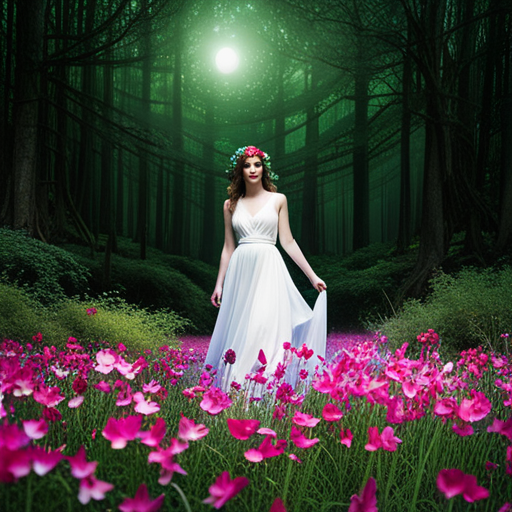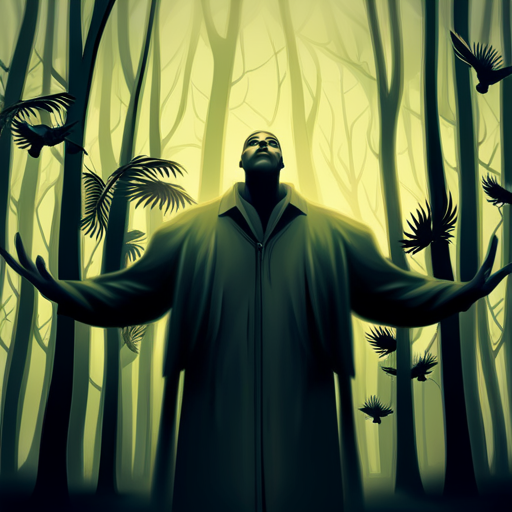So you believe you have Shakespeare completely understood? Well, get ready to be mesmerized, as there is a plethora of symbolism concealed within the fanciful story of ‘A Midsummer Night’s Dream.’
As you delve into this magical world, you will discover that every character, every scene, and every line is brimming with deeper meanings and hidden messages. From the enchanting power of the magical flower to the moonlit forest that serves as the backdrop for countless lovers’ quarrels, Shakespeare weaves a web of symbols that will leave you spellbound.
And let’s not forget the mischievous Puck, who embodies the very essence of chaos and mischief. But amidst all the chaos, there is a deeper message about the power of dreams and the role they play in our lives.
So buckle up, dear reader, for we are about to embark on a journey through the intricate world of symbols in ‘A Midsummer Night’s Dream.’
Key Takeaways
- The magical flower represents the unpredictable nature of love.
- The forest serves as a metaphorical escape from societal constraints.
- Power and authority are explored through the conflict between Titania and Oberon.
- Trickery and deception are central themes, highlighting the fragility of love and the power of manipulation.
The Magical Flower
The magical flower’s sweet scent enchants all who come near, its petals glowing with a brilliant, otherworldly hue.
In A Midsummer Night’s Dream, the magical flower serves as a powerful symbol, representing the transformative and unpredictable nature of love. When its nectar is applied to a person’s eyes, it causes them to fall deeply in love with the first creature they see upon waking. This symbolizes the irrationality and fickle nature of love, as it can instantly change the course of one’s emotions.
The effects of the magical flower are both hilarious and chaotic, leading to mistaken identities and absurd romantic entanglements.
As we transition into the subsequent section about the moonlit forest, we witness the consequences of this magical flower’s spell and the further complications that arise in this enchanted realm.
The Moonlit Forest
Step into the ethereal, moonlit forest and let the enchanted glow guide you through the whimsical world of A Midsummer Night’s Dream.
As you wander through the mystical woods, you will encounter a series of enchanted encounters that will leave you captivated.
The moonlight filters through the dense foliage, casting an otherworldly glow on the forest floor. Shadows dance and flicker, creating an atmosphere of intrigue and mystery.
You may stumble upon supernatural enchantment, as fairies flit through the air, casting spells and weaving their magic.
The forest becomes a stage for mischievous pranks and romantic entanglements, all under the watchful gaze of the moon.
As you immerse yourself in this enchanting world, you will be transported to the fairy kingdom, where even more magical adventures await.
The Fairy Kingdom
In the Fairy Kingdom, fantasy and imagination reign supreme, transporting you to a world where anything is possible. Here, power and authority are wielded by the mischievous and magical fairies, who play tricks and manipulate events to their advantage.
As you delve deeper into this enchanting realm, you’ll uncover a web of trickery and deception, where appearances can be deceiving and nothing is as it seems.
Fantasy and Imagination
Imagine yourself transported to the whimsical world of A Midsummer Night’s Dream, where fantastical elements and imaginative symbols abound. In this enchanting play, Shakespeare explores the power of creative inspiration and the allure of escapism and fantasy.
Here are three key symbols that highlight these themes:
-
The Fairy Queen, Titania: Titania represents the beauty and magic of the natural world. Her presence evokes a sense of wonder and awe, inspiring creativity and imagination in the audience.
-
The Love Potion: This symbolizes the transformative power of love and the ability to escape reality. The love potion causes characters to fall in and out of love, blurring the lines between reality and fantasy.
-
The Forest: The forest serves as a metaphorical escape from the constraints of society. It represents a place where dreams and desires can run wild, free from the rules and expectations of the human world.
Now, as we transition into the next section on power and authority, we explore how these fantastical symbols intersect with the themes of control and dominance.
Power and Authority
Titania’s regal presence in the whimsical world of A Midsummer Night’s Dream alludes to the intricate web of power and authority that governs both the human and fairy realms. As the queen of the fairies, Titania wields considerable power, but this power isn’t immune to abuse.
Her conflict with Oberon, the fairy king, showcases the potential for the abuse of power even in the realm of fantasy. Additionally, the subversion of authority is evident in the play’s portrayal of the mechanicals, a group of commoners who temporarily take on roles of power and authority within the play-within-a-play. This subversion highlights the fragility of power structures and the potential for individuals to manipulate and disrupt them.
Transitioning into the subsequent section about ‘trickery and deception,’ the play delves further into the complexities of power dynamics within its fantastical setting.
Trickery and Deception
Engage in the intricate dance of trickery and deception, where the boundaries between reality and illusion blur, and you’ll find yourself captivated by the mischievous nature of A Midsummer Night’s Dream. Shakespeare masterfully explores the theme of trickery and deception, particularly in the realm of relationships.
The characters in the play manipulate emotions and deceive one another, creating chaos and confusion. For instance, Puck, the mischievous fairy, plays tricks on the mortal characters, causing them to fall in love with the wrong person. The love potion he uses amplifies the deception in the relationships, leading to mistaken identities and misplaced affections.
This theme of deception highlights the fragility of love and the power of manipulation. As we move into the subsequent section about the wedding celebration, the consequences of these deceptions become even more apparent.
The Wedding Celebration
During the wedding celebration in A Midsummer Night’s Dream, the vibrant and colorful flower garlands worn by the characters symbolize the joyful and festive atmosphere of the occasion. These garlands, made of flowers such as roses, lilies, and daisies, are intricately woven together and worn as crowns or necklaces. They serve as a visual representation of the love and happiness that surrounds the wedding ceremony. The fairies, who play a significant role in the play, are also present during the celebration, adding an element of magic and enchantment. Their mischievous nature and antics provide comedic relief throughout the play, further highlighting the lightheartedness of the wedding festivities. As the garlands adorn the heads and necks of the characters, they create a sense of unity and celebration, setting the stage for the ensuing lovers’ quarrels.
The Lovers’ Quarrels
In the Lovers’ Quarrels subtopic of A Midsummer Night’s Dream, you’ll explore the themes of confusion and mistaken identity, passion and jealousy, and true love and devotion.
These key points drive the conflicts and complexities within the relationships of the characters. Through the use of magical interventions and misunderstandings, Shakespeare masterfully delves into the intricacies of love, revealing the transformative power it possesses.
As you delve into this subtopic, you’ll gain a deeper understanding of the human emotions and desires that fuel the dramatic moments in the play.
Confusion and Mistaken Identity
Amidst the enchanting chaos of A Midsummer Night’s Dream, confusion and mistaken identity reign, weaving a captivating web of comedic mishaps and unexpected encounters. The play is rife with instances of mistaken identity and confusion, which serve to heighten the comedic misunderstandings that occur. These instances include:
1) Helena mistaken for Hermia, leading to a series of comical miscommunications and misunderstandings between the characters.
2) Oberon’s use of a love potion on the wrong person, resulting in a hilarious mix-up between Lysander and Demetrius.
3) The transformation of Bottom into a donkey, causing further confusion and amusement among the characters.
Through these instances of mistaken identity and confusion, Shakespeare expertly creates a world where anything can happen and the line between reality and illusion is blurred.
As we delve into the next section about passion and jealousy, the stage is set for even more dramatic and unpredictable twists.
Passion and Jealousy
In the realm of passion and jealousy, the characters of ‘A Midsummer Night’s Dream’ find themselves entangled in a web of unrequited love, betrayal, and revenge. Shakespeare masterfully uses these themes to highlight the volatile nature of human emotions and the consequences that arise from acting upon them.
Throughout the play, we witness the unrequited love of Helena, who relentlessly pursues Demetrius, only to be rejected time and time again. This unrequited love drives her to desperate measures, as she becomes entangled in a complex love triangle.
Additionally, the theme of betrayal and revenge is prevalent, as Oberon seeks revenge on his unfaithful wife, Titania, by using a love potion to humiliate her. These themes serve to intensify the chaos and confusion that permeate the play, leading us into the next section, where true love and devotion take center stage.
True Love and Devotion
Experience the transformative power of true love and unwavering devotion as you witness the characters of ‘A Midsummer Night’s Dream’ surrender their hearts to the irresistible force of their deepest desires.
In this enchanting tale, true love’s endurance is portrayed through the sacrifices made in the name of love.
-
Hermia’s defiance: Despite her father’s wishes, Hermia remains loyal to her true love, risking her own life to be with him.
-
Helena’s unrequited love: Helena’s unwavering devotion to Demetrius is evident as she willingly endures his rejection and pursues him relentlessly.
-
Oberon’s intervention: The Fairy King’s actions in the name of love demonstrate his dedication to Titania and his desire to restore harmony.
-
Bottom’s transformation: Through the power of love, Bottom is transformed into an object of desire, highlighting the unpredictable nature of love.
As the characters navigate the complexities of true love and devotion, their journey leads them to a play within the play, where the lines between reality and illusion blur.
The Play Within the Play
Amongst the chaos of the world of A Midsummer Night’s Dream, you’ll witness a captivating play within the play, where the characters’ lives become intertwined and their true desires are revealed.
This play, performed by the Mechanicals, showcases a role reversal where the lowly craftsmen take on noble roles. This inversion of social hierarchy adds a comedic element to the play, highlighting the absurdity of human ambition and the fickleness of power.
The significance of this performance lies in its ability to mirror the events and themes of the main storyline. It serves as a reflection of the chaotic love affairs and mistaken identities that unfold throughout the play, emphasizing the transformative power of love and the unpredictability of fate.
With the conclusion of the play within the play, we are introduced to the mischievous character of Puck, who’ll play a pivotal role in the subsequent events.
The Character of Puck
When discussing the character of Puck in A Midsummer Night’s Dream, it is impossible to ignore his mischievous nature and penchant for pranks. Puck’s actions throughout the play consistently bring chaos and confusion to the lives of the other characters, whether it’s through the use of love potions or his shape-shifting abilities.
However, beneath Puck’s mischievous exterior lies a sense of loyalty and obedience, as he always follows the orders of his master, Oberon. This combination of mischief, transformation, chaos, loyalty, and obedience makes Puck a complex and intriguing character within the play.
Mischief and Pranks
In the whimsical world of "A Midsummer Night’s Dream," mischief and pranks abound, creating a lively atmosphere full of mischievous antics and playful tricks.
Puck, the mischievous sprite, is the mastermind behind these tricks and pranks, delighting in causing annoyance and mischief among the characters. Puck’s mischievous nature is evident in his actions. He transforms Bottom’s head into that of an ass and causes the lovers to fall in and out of love with the wrong person.
These tricks not only add humor to the play but also serve to disrupt the order and stability of the mortal world. As the play progresses, the mischief and pranks escalate, leading to a state of transformation and chaos.
The mischievous spirit of Puck and his tricks set the stage for the ensuing chaos and confusion in the world of "A Midsummer Night’s Dream."
Transformation and Chaos
Amidst the whirlwind of mischief and pranks, the world of A Midsummer Night’s Dream undergoes a tumultuous metamorphosis, akin to a wild storm tearing through a peaceful meadow.
The transformative power of magic is at the heart of this chaos and disorder. The play is filled with instances of characters being transformed, either physically or emotionally, resulting in unforeseen consequences.
The mischievous Puck, with his love potion, causes chaos by causing the wrong people to fall in love and disrupting the established order of relationships. The consequences of these magical transformations are far-reaching, leading to confusion, jealousy, and heartache.
The disruption of order highlights the fragile nature of human relationships and the unpredictable consequences of meddling with the natural course of events. As the storm of transformation and chaos subsides, it paves the way for the exploration of loyalty and obedience in the enchanted world of the play.
Loyalty and Obedience
Embrace the loyalty and obedience that bind the characters in this enchanted world, where their actions intertwine to create a harmonious symphony of devotion.
Loyalty versus betrayal is a recurring theme in A Midsummer Night’s Dream, as characters grapple with their sense of duty and the temptation to break away. Helena’s unwavering loyalty towards Demetrius, despite his rejection, showcases her commitment to love. On the other hand, Hermia’s refusal to obey her father’s orders and follow her heart demonstrates her determination to be true to herself.
However, blind obedience also plays a role, as the fairy servants unquestioningly follow Oberon’s orders, leading to chaos and mischief. This exploration of loyalty and obedience adds depth to the characters’ motivations and actions, revealing the complexities of human nature.
Transitioning into the subsequent section about ‘the power of dreams,’ the characters’ loyalty and obedience are further tested as they navigate the whimsical realm of their subconscious minds.
The Power of Dreams
Dreams, like ethereal whispers, hold within them the transformative power to shape reality in A Midsummer Night’s Dream. They act as powerful visions, revealing the characters’ deepest subconscious desires.
These dreams serve as a catalyst for the chaos and confusion that unfolds in the play. For example, when the mischievous fairy, Puck, administers the love potion to the wrong person, it sets off a chain of events where the characters’ dreams become intertwined, leading to mistaken identities and romantic entanglements.
The power of these dreams is further emphasized by their ability to alter the characters’ perception of reality, blurring the lines between the waking world and the dream realm. As the play progresses, the characters must navigate the unpredictable nature of their dreams, highlighting the transformative and unpredictable power they possess.
This exploration of dreams and their impact on reality sets the stage for the subsequent section about the symbolism of the title, emphasizing the interconnectedness between dreams and the symbolism that permeates the play.
The Symbolism of the Title
In the enchanting realm of Shakespeare’s play, the title itself serves as a doorway to a world where reality merges with the fantastical, inviting us to uncover the hidden layers of meaning woven throughout the story.
The symbolism of dreams is a central theme in A Midsummer Night’s Dream, as it explores the transformative power of the subconscious mind. Dreams are portrayed as a bridge between the conscious and unconscious realms, allowing characters to explore their desires, fears, and hidden truths.
The significance of the night further enhances this theme, as darkness represents the unknown and the mysterious. It is during the night that the characters’ true desires and emotions are revealed, blurring the line between reality and illusion.
As we delve deeper into the play, we discover that these symbols of dreams and the night are intricately connected to the larger themes and messages of the play, guiding us towards a greater understanding of Shakespeare’s masterful work.
The Themes and Messages of the Play
Love, deception, and transformation are central themes in A Midsummer Night’s Dream, intertwining to create a complex and captivating narrative. The play explores the power of love and the chaos it can create, as characters navigate through various romantic entanglements.
Love is depicted as both a force of enchantment and a source of confusion, as characters become entangled in the magic of the fairy realm. This realm, inhabited by fairies such as Oberon and Titania, serves as a symbol of chaos and transformation. The fairy realm represents a world where reality is blurred, where love potions can alter the course of relationships and create unlikely pairings.
Through the use of symbolism, Shakespeare highlights the unpredictable and transformative nature of love, reminding us of the complexities and mysteries that lie within our own hearts.
Frequently Asked Questions
What is the significance of the play within the play in "A Midsummer Night’s Dream"?
The significance of the play within ‘A Midsummer Night’s Dream’ lies in its role as a performance. It serves as a reflection of the main plot, mirroring the themes of love, illusion, and transformation.
The play within the play, titled ‘Pyramus and Thisbe,’ allows the characters to explore their own emotions and desires through the lens of a comedic tragedy. It adds depth and complexity to the storyline, highlighting the power of theatricality and the transformative nature of art.
How does the character of Puck contribute to the overall themes and messages of the play?
Puck, with his mischief and trickster nature, plays a crucial role in conveying the themes and messages of ‘A Midsummer Night’s Dream.’ As a mischievous fairy, Puck carries out Oberon’s commands, causing chaos and confusion among the characters. This highlights the unpredictable nature of love and the power of magic.
Puck’s actions also emphasize the theme of illusion versus reality, as his pranks blur the line between what’s real and what’s imagined. His presence adds a sense of whimsy and enchantment to the play, reinforcing its magical and fantastical atmosphere.
What is the symbolism behind the power of dreams in the play?
The power of dreams in A Midsummer Night’s Dream is symbolic of the transformative and unpredictable nature of love. Like a swirling vortex, dreams in the play possess the ability to transport characters to fantastical realms and alter their perceptions of reality. They serve as catalysts for the chaotic events that unfold, blurring the lines between illusion and truth.
Through this symbolism, Shakespeare explores the profound impact that love and desire can have on individuals, challenging their perceptions and pushing them to the brink of madness.
Why is the title "A Midsummer Night’s Dream" considered symbolic?
The title ‘A Midsummer Night’s Dream’ is considered symbolic because it captures the essence of the play’s themes and motifs.
The use of ‘Midsummer’ suggests a time of transition and enchantment, where reality and fantasy merge.
‘Night’ emphasizes the mystical and transformative nature of dreams.
Additionally, ‘Dream’ symbolizes the power of imagination and the blurred boundaries between the conscious and subconscious mind.
These elements contribute to the overall significance of dream symbolism in the play titles.
What are some of the main themes and messages conveyed throughout the play?
Throughout ‘A Midsummer Night’s Dream,’ one of the main themes is the role of love. Shakespeare explores the various forms of love, from romantic infatuation to unrequited love. The play also delves into the complexities and irrationality of love, as seen through the actions of the characters.
Additionally, the use of magic and fantasy serves to convey the themes of transformation and the blurred lines between reality and illusion. These elements create a whimsical and enchanting atmosphere that enhances the overall message of the play.
Conclusion
In conclusion, A Midsummer Night’s Dream is a play filled with rich symbolism that adds depth and complexity to the narrative.
From the magical flower that represents love and desire, to the moonlit forest that embodies mystery and enchantment, each symbol serves to enhance the themes and messages of the play.
Just like the intricate weaving of a tapestry, these symbols intertwine and create a vivid and captivating portrayal of love, dreams, and the power of imagination.
A Midsummer Night’s Dream is truly a masterpiece, where every symbol shines like a star in the night sky, illuminating the beauty and complexity of Shakespeare’s work.










